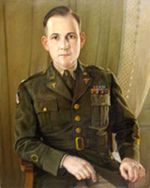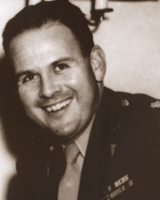Colo nel Forrest Hull, MD (1911-2004) had a long an interesting career as a military ophthalmologist. It began in 1938 when a young Forrest Hull was taking his internship at the San Diego County General Hospital. His father, a former medical officer in World War I, advised him to consider a life in the Army. Hull agreed and he was commissioned that year into the Army Medical Corps at Fort McArthur, California.
nel Forrest Hull, MD (1911-2004) had a long an interesting career as a military ophthalmologist. It began in 1938 when a young Forrest Hull was taking his internship at the San Diego County General Hospital. His father, a former medical officer in World War I, advised him to consider a life in the Army. Hull agreed and he was commissioned that year into the Army Medical Corps at Fort McArthur, California.
Dr. Hull gained additional medical training from the Army and eventually joined the Fifth Infantry Division as a unit surgeon. At the outbreak of war, Dr. Hull’s unit was in Iceland practicing winter maneuvers and he had the rank of Captain. Although eager to join the war front, Dr. Hull was shipped back to the United States to join the 75th Infantry Division and ordered to attend Commander General Staff College in Fort Leavenworth, Kansas. He graduated in 1943, the only physician in his class. In late 1944, Dr. Hull’s division was finally sent to the European front where they fought in the Battle of the Bulge. For his service in battle, Dr. Hull was awarded the Bronze Star.

At the end of the war, Dr. Hull was promoted to Lieutenant Colonel and worked for a short period of time at the Pentagon, but he requested to train in ophthalmology and was sent to Walter Reed Hospital in Washington DC. Unfortunately, there was no official residency program there, so Dr. Hull and his colleagues forged one from the staff at Walter Reed and nearby Johns Hopkins. Dr. Hull was one of the first to finish his residency at Walter Reed and passed the American Board of Ophthalmology exams in 1948.
From Washington DC, he was stationed as an ophthalmologist at the Tokyo Army General Hospital in occupied Japan until he was called to active service yet again in the Korean War. In 1953, Dr. Hull was finally back home in the United States. He resigned his post and joined the California National Guard. In 1974, Colonel Hull retired from military service altogether.
In 2002 Dr. Hull sat down to talk about his life and experiences for the Museum of the Eye® Oral History Project.